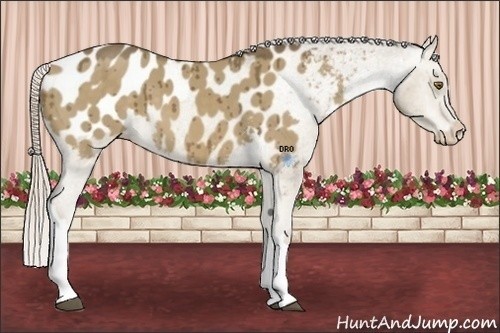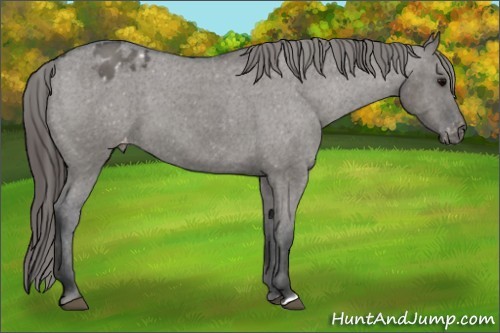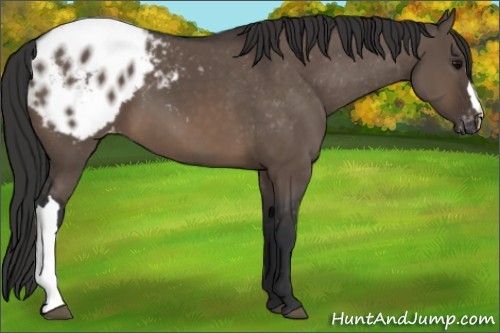Intro to Appaloosa Genetics
This article will introduce you to the building blocks of Appaloosa Genetics for Hunt&Jump. After you have finished reading, you should be able to start your own program!
Proposed Talking Points
- In Game Vocabulary
- The Appaloosa Spotting Genes
- Hidden Interactions in Appaloosa Spotting
- Genes Independent of Appaloosa Spotting
In Game Vocabulary
In Game Vocabulary
Allele: It is a variant, or mutation, to a gene (e.g., LPP1 and LPP2 are Alleles of the LP Promoter Gene). Rarely used in H&J language, but seen in this article.
Appaloosa Characteristics: Appaloosa (LP) will add mottling to the horses skin as well as Varnishing. Also see Bronzing in this article.
Gene: A section of DNA that codes for a specific inheritance (e.g., Appaloosa is the Gene). For the purpose of H&J, Alleles are called Genes. Genes are what give our horses a variety of colors and patterns.
Gene Modification Treatment: An in-game service that allows you to see and modify most of your Horses Genes.
Heterozygous: One copy of an Allele (i.e., LP/-). See this section for more information.
Homozygous: Two copies of the same Allele (i.e., LP/LP). See this section for more information.
Incomplete Dominant: Two copies of a Gene will have greater expression than one copy of a Gene.
Pigment Density: How concentrated (i.g., dark) a horses color is. Black is more dense than Bay, and Bay is more dense than Chestnut.
Recessive: Will only show the effect when two copies (i.e., Homozygous) of the Allele are present.
Varnishing: A Different Pattern from Roan or Gray, this Gene progressively lightens a horses color by the addition of White hairs throughout the coat.
The Appaloosa Spotting Genes
The Appaloosa Spotting Genes are probably the most dynamic genes in all of Hunt & Jump, which means they are also the most complicated to understand. I've been breeding them for years, and still find new things to learn about. Generally speaking your Appaloosa Spotting Genes are going to be influenced by three primary factors:
- Other Appaloosa Spotting Genes
- Pigment Density
- Age
|

Chestnut LP/-, PATN1/-, Vrn/Vrn
|

Chestnut LP/-, PATN1/-, LPP1/-, Vrn/Vrn
(the addition of the LPP1 Allele increased Blanket size)
|
|

Liver Chestnut LP/-, PATN1/-
|

Liver Chestnut LP/-, PATN1/-, Cr/-, D/-, mu/-
(the addition of Dilution genes reduces Pigment and increased Varnishing from LP)
|
|

|

The same horse on the left, but at age 23
|
The Appaloosa Spotting Genes
|

Black LP/-, Vrn/-
|

Bay Dun LP/-, PATN1/-, Vrn/Vrn
|
|
Appaloosa (LP)
Heterozygous LP allows Appaloosa Characteristics to be visible on the horse. While Homozygous LP does not increase the expression of Appaloosa Characteristics, but may increase the expression of additional Appaloosa Spotting Genes.
|
Appaloosa Blanket Size (PATN1)
This is the primary gene for controlling a horses Blanket size. PATN1 is an Incomplete Dominant gene and can be influenced by additional genes. Must have at least one copy of LP to be shown.
|
|

Bay LP/-, snow/snow
|

Brown Dun LP/-, PATN/-, LPP1/-, ASR1/-, H/H
|
|
Snowflake Varnish (snow)
This gene alters normal Varnishing into white speckles, which grow in size and quantity over the horses lifetime. Snowflake Varnish is Recessive, and requires two copies (i.g., Homozygous) to be expressed. Must have at least one copy of LP to be shown, and may be affected by other genes. This gene will not affect Spots on the horses coats.
|
Varnish Regulator 2 (H)
Also known as Halo Spots or Peacock Spots, this gene causes a Varnished ring around Spots. The act of Haloing can make the Spot appear smaller. This gene is Incomplete Dominant, and its expression will strengthen over a horses life time. Must have one copy of LP to be shown, and can be influenced by other genes. Two copies of LP will remove Spots.
|
|

Chestnut LP/-, PATN1/-, LPP1/LPP1, ASR1/ASR1
|

Bay LP/-, LPP1/LPP2, Vrn/-
|
|
Appaloosa Spot Regulator (ASR1)
This Incomplete Dominate Gene modifies Spot Size, and can be influenced by other genes. Must have one copy of LP to be shown. Two copies of LP will remove Spots.
|
Varnish Promoter (Vrn)
The presence of this gene will increase Appaloosa Varnishing. This gene is Incomplete Dominant, and its expression will strengthen over a horses life time. It can also be influenced by other genes. Must have at least one copy of LP to be shown. This gene will not affect Spots on the horses coats.
|
|

Homozygous LPP1
Bay Dun LP/-, PATN1/-, LPP1/-
|

Heterozygous LPP2
Bay Dun LP/-, PATN1/-, LPP2/-, Vrn/-
|
|
LP Promoter
This Incomplete Dominate Gene modifies Blanket and Spot Size. The two Alleles in this gene, LPP1 and LPP2 can work together or independently of PATN1 to produce a wide range of Blanket sizes.
|
LPP1 - Extends the PATN1 Blanket, but Spot size remains the same.
LPP2 - Blanket size typically spreads further with LPP2, and Spot size decreases.
View this Study for more examples with PATN1.
|
Hidden Interactions in Appaloosa Spotting
Hidden Interactions in Appaloosa Spotting
Unknown Hidden Appaloosa Blanket Size Gene
When searching for horses, under Appaloosa Blanket Size you can select "must not have" for both options (- and PATN1). If no Pattern Genes are present, horses should technically be solid or near solid looking.

According to players on the Bluegrass Forum, this hidden gene is called PATN2, but I have seen mixed reports on what it looks like.
Need clarification from Ammit about what is or isn't going on
When Using Gene Modification Treatment (GMT)
By viewing your horse in the Gene Modification Treatment Lab, you will most likely see the majority of their genes. However there are some genes that are hidden and unknown to us. One way to verify that our horses have something extra is by checking to see if we can alter the Gene. Below are the messages you may receive when checking to see if you can alter the PATN1 gene.
|

|
|
In this example the horse is PATN1/-. First we check to see if we can alter the PATN1 Allele, and are given the option to change it to the - Allele. This means the only two options for Alleles here is PATN1 or nothing.
|
 |
|
By checking the - Allele, we see we have the option to change it to PATN1. This means we could potentially make our horse one of the following combinations:
- PANT1/-
- PATN1/PATN1
- -/-
|
 |
| However, sometimes the - Allele is actually a Hidden Gene, and we can't directly test for it. But by checking in the GMT lab we can see if something is there when this message pops up. So here I have a horse with the - Allele, but it's not the same - Allele as before. It's a secret shhhh. |
Appaloosa Bronzing
Appaloosa Bronzing is considered an Appaloosa Characteristic, but has no known genetic control. Instead it is influenced by Pigment Density. Bronzing lightens the mane and tail, the lighter the horse, the greater the Bronzing. There are other genes that may mimic Bronzing, such as Cream, Dun, and Roan.
|

Bay LP/-, PATN1/-, LPP2/- (No Darkening Genes or Varnish Promoter)
|
|
Dense Pigment
(e.g., Black & Brown)
|
|
Less Dense Pigment
(e.g., Bay & Chestnut)
|
| No Bronzing |
----------> |
More Bronzing |
Genes Independent of Appaloosa Spotting
Genes Independent of Appaloosa Spotting
The following genes do not affect Appaloosa Spotting Genes, but you may see them on Appaloosas depending on other genes they carry.
Kit Genes
Splash Genes
Frame
Phantom Genes
White Factor
This information was compiled by Cheshire Farms on the Bluegrass Server and is current as of November 26, 2023.
Special thank you to Ammit and Cheshire Farms for contributing photos to this article.



















